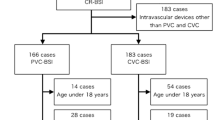Abstract
Objective: To determine the incidence of central catheter-related bloodstream infection (CR-BSI) and to compare patient and catheter characteristics of those with and without CR-BSI from a clinically suspected subgroup. Secondly, to assess the efficacy of the acridine orange leucocyte cytospin test (AOLC) as a rapid in situ method of detecting central venous catheter (CVC) infection. Design: One-year prospective audit. Setting: Intensive care unit/high dependency unit (ICU/HDU) and general wards of a tertiary referral hospital. Patients and participants: 400 patients with non-tunnelled CVCs. Interventions: Daily surveillance, blood culture from peripheral venepuncture, blood sample from the CVC for assessment of the AOLC test and removal of suspected CVCs were carried out on patients clinically suspected of having CR-BSI. Measurements and results: CR-BSI was diagnosed using well defined criteria. Infection rate was calculated by dividing the number of definitive catheter associated infections by the total number of appropriate catheter in situ days. The AOLC test was performed on all those with suspected CR-BSI. A total of 499 CVCs in 400 patients were assessed, representing 3014 catheter in situ days. Over 80 % of patients were from our ICU/HDU, representing 404 CVCs and 1901 catheter in situ days. A total of 49/499 (9.8 %) CVCs in the same number of patients were suspected of being infected subsequently 12/499 (2.4 %) CVCs [95 % confidence interval (CI) 1.25 to 4.16] in 12 separate patients were demonstrated to be the direct cause of the patient's BSI. Rates of CR-BSI per 1000 catheter days were 3.98 (95 % CI 2.06 to 6.96) for the whole cohort and 4.20 (95 % CI 1.81 to 8.29) for the ICU/HDU subgroup. In the group suspected of having CR-BSI, CVCs were removed unnecessarily in 55 %, and no patient or catheter variables measured were predictive of the development of CR-BSI. The AOLC test was negative in all 12 catheters subsequently shown to be the definitive cause of BSI. Conclusions: We have defined the incidence of CR-BSI in a cohort of patients from a tertiary referral hospital, the rates comparing favourably with those reported for similar populations. We were unable to demonstrate significant differences in any patient or catheter variables between those with and without CR-BSI. The AOLC test used alone was unhelpful as a method to diagnose in situ CVC infection in this patient population.
Similar content being viewed by others
Author information
Authors and Affiliations
Additional information
Received: 26 February 1998 Accepted: 30 June 1998
Rights and permissions
About this article
Cite this article
Gowardman, J., Montgomery, C., Thirlwell, S. et al. Central venous catheter-related bloodstream infections: an analysis of incidence and risk factors in a cohort of 400 patients. Intensive Care Med 24, 1034–1039 (1998). https://doi.org/10.1007/s001340050712
Issue Date:
DOI: https://doi.org/10.1007/s001340050712




